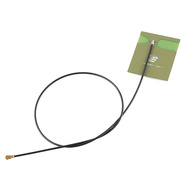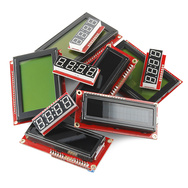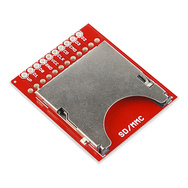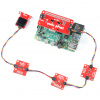Hello everyone and welcome to another round of new products to end the week. Check them out and hopefully there's something here you'll find useful.
Vimeo version found here.
Just to reiterate if you didn't watch the video, I'll be on vacation for the next week or so. Nick will be covering for me so you'll still have a product video and such next week, but I won't be around.
We're finally carrying magnet wire! This magnet wire kit consists of 3 separate gauges of magnet wire (22, 26, and 30) of varying feet. If you're not familiar with magnet wire, it's a conductive wire that has a very thin layer of insulation on the outside. It's used commonly in applications where you need several windings of wire, but don't want it to short out, such as transformers, voice coils, or solenoids.
Now that you've got wireless working on your project, you might want an antenna to increase your signal strength. This 2.4GHz antenna is adhesive, small, and is terminated with a U.FL connector so it mates well to XBees, the WiFly module, and many other boards.
Our ding and dent scrap boards have always been popular. You almost never see them in stock because as soon as we have them, they're snatched up almost instantly. Today, we add a new ding and dent product, the LCD Ding and Dent. This includes everything you see above (the shot is an actual representation of what's in stock right now). LCD backpacks, complete serial LCDs, alphanumeric displays and more are yours to be tinkered with!
A customer pointed out to us that we didn't have a basic blue 5mm LED. We have a super bright blue, but not just a standard one. So, why not, right? Here it is, a basic 5mm blue LED. It has a opaque blue lens, which makes it easier to pick out than the clear ones.
A few weeks back I talked about how there was a running change on the SD card sockets we get. Because of this we needed to revise all the products that used them. First up was the SD Sniffer. It's the same product as before, but uses the new SD socket, which has a slightly different footprint. The SD Sniffer lets you look at the SPI traffic while using an SD card. Put the card into the sniffer, plug the sniffer into a socket, and use a logic analyzer or microcontroller to view the signals that are being passed back and forth. Nifty.
In addition to revising the SD Sniffer above, we needed to revise the breakout board as well. Once again, nothing has changed except for the pads on the PCB since the footprint for the socket changed. So, we've got the situation taken care of and both of these products are back in stock!
That's all we have for this week. Thanks for reading and I'll see you back in a couple of weeks, but be sure to check back next week where Nick will have new products for you!














From the English closed captions...
"welcome to yet again another frightening product post"
Ah, thank you Robert... I think...
It's the beard, isn't it?
Every time he says 'um' it picks it up and has some hilarious effects.
I love SparkFun
Wouldn't the lens on the blue LED be translucent? I don't think we'd get much light if it was opaque.
Robert that box is still askew.
Safe travels, Robert! (hopefully going somewhere fun w/your bride)
Nick, nice work on the speakers. They're very simple devices, and at least you got some sound out of them. Maybe the magnets you were using were too strong?
Entirely possible. You know what's funny is that I spent like an hour on that acrylic, fixed-coil speaker and it performed... well... as expected. Then I built that second one out of a paper cup and I don't know if you can tell in the video but it worked WAY better.
Doesn't surprise me... The acrylic was thick and difficult to vibrate so doesn't contribute noticeably to the sound generation, in contrast the paper cup isn't quite as good at vibrating as the thin diaphram but it's much larger and shaped like a cone (so a large volume of air is moved).
I was about to ask what that black thing hanging into the cup at the end of his demo was, and then I realized it was a mic. I'm so smart.
Conductive wire? Is there such a thing as non-conductive wire?
Of course, polymer monofilament wire... AKA plastic fishing line.:p
That beard is frightening....
"Don't do that at home." @5:14. Just the way you said it made me laugh. Great demo.
Hahaha, thanks. That was the sound of me realizing that a roll of Kapton tape isn't something a lot of people have "laying around." Incidentally, as a testament to my geekitude: of all the incredible "mistakes" made on the YouTube auto-transcription, the substitution of "polyamide" for "polyimide" is the one that irks me the most... not that I would expect a speech-to-text engine to understand the difference between Kapton and Nylon.
Haha, I gave up on the YouTube cc after trying to watch a video of a guy with a heavy accent demo his gumstix.
I really do like the demo though. It has a very personal feel to it. You seemed to really enjoy the project which makes it a lot more interesting to the viewers. I know I'm not the only one who saw it and thought "I wonder how big of a speaker I could make like that." Instructables and similar sites with mostly pictures are great but they lack the enthusiasm.
Nick, after you cut out the acrylic, what did you do to "weld" or glue the pieces together to get your cube? Just hot glue?
Yup, just hot glue. I never put a lot of trust in hot glue until I started doing projects with tight deadlines and was forced to use it as opposed to, say, a binary epoxy, and I've found that as long as you're using a high-temp glue and you know its limitations, it's really great stuff (Not just for arts and crafts class anymore!)
I have to laugh at the SD sniffer. Especially since SD stands for "Secure Digital" it makes me crack a smile :D
Ok why is it better to put the coil on the diaphragm? Is it because it has less mass?
I believe that's exactly why.
Awesome, but what was the music?!
It's actually mine: http://sunflowersatchernobyl.bandcamp.com/track/au-francais
That way we avoid playing some other artist's music poorly and without permission, lol.
Cool product video and all, but you guys should have a random alt section of Sparkfun for creations from Sparkfun creations.
This stuff is great!
great track!
Purchased!
Thanks! Creative exposure wasn't really my goal here but I'm glad everyone enjoyed it, lol
Purchased!
Thanks for your support!
... Very cool. I'm thinking that the next video needs a bespoke soundtrack!
HA! Thanks for the link. It's enjoyable.
Nick, try a air core coil, you should get much more volume with that because the magnet won't be so strongly magnetized to the core of your coil.
Haha, Yeah. That design was pretty seriously flawed for a few reasons. You're right, an air coil would perform a lot better. As it is, because I didn't have a stretchy material for the diaphragm and I didn't have any easy way to keep tension in it, the magnet's attraction to the core is what keeps tension (yup) so not only is the whole thing dampened, but the diaphragm doesn't keep it's shape in deflection, lol
Nick, How did you measure the inductance of the coil you made?
Your video has me wanting to turn everything into a speaker.
I didn't, haha. I measured what I called the impedance throughout the video but I was really giving you the resistance, the nominal impedance was probably slightly higher.
Measuring the inductance of a coil requires some cleverness. In this case cleverness means math and a good meter.
The LCD Ding and Dent link is bad.
Yeah - was accidentally an internal link. Should be fixed now. Thanks!